Ivan Čuk
Editorial
Lauren A. Burt, Geraldine A. Naughton, Dean G. Higham and Raul Landeo
TRAINING LOAD IN PRE-PUBERTAL FEMALE ARTISTIC GYMNASTICS
Maja Bučar Pajek, Ivan Čuk, Marjeta Kovač and Barbara Jakše
IMPLEMENTATION OF THE GYMNASTICS CURRICULUM IN THE THIRD CYCLE OF BASIC SCHOOL IN SLOVENIA
Lurdes Ávila-Carvalho, Maria da Luz Palomero, Eunice Lebre
APPARATUS DIFFICULTY IN GROUPS ROUTINES OF ELITE RHYTHMIC GYMNASTICS AT THE PORTIMÃO 2009 WORLD CUP SERIES
Thomas Heinen, Pia Vinken in Patrick Ölsberg
MANUAL GUIDANCE IN GYMNASTICS: A CASE STUDY
Ivan Čuk and Warwick Forbes
HOW APPARATUS DIFFICULTY SCORES AFFECT ALL AROUND RESULTS IN MENS ARTISTIC GYMNASTICS
Ivan Čuk
Editorial
Dear friends,
A year has gone by since we published the first issue of our journal, so we can congratulate ourselves on achieving our first birthday! As this issue is also our last of the year, perhaps some statistics are appropriate.
In 2010 alone we published 15 articles by authors from various countries including (in alphabetical order) Australia, Finland, Germany, Greece, Hungary, Portugal, Slovenia, and the United States of America. From the journals inception in October 2009 to the beginning of 2010, 6 articles were published also by authors from Bosnia and Herzegovina, China, and Croatia. This results in a total of 21 published articles by authors from 11 different countries. Our friend from the editorial board William Sands (USA) wrote for the successful SIGARC symposium in Sao Paolo Campinas: less scientific articles on gymnastics topics have been published in recent years (by PubMed Database) comparing to decades ago. Through the SIGARC symposium and our journal we are increasing the number of articles in the gymnastics field. Authors have written from a wide range of scientific paradigms. We started in 2009 with medicine, biomechanics, didactics, and terminology; continuing in 2010 with psychology, motor control, metrics, history, and the theory of training. Topics dealt with high performance sport, physical education, and rehabilitation. Samples also represented a wide range of gymnastics disciplines and included participants from men’s artistic gymnastics, women’s artistic gymnastics, and rhythmic gymnastics. We hope in the near future to publish articles from trampolining, acrobatics, and aerobics. It is worth noting that studies were not solely concerned with athletes, but judges and Code of points were also analysed.
It is hoped that the research published in this journal will inform everyday practice in our field of gymnastics. Keith Russell (Canada) the president of the FIG Scientific Commission shares this vision, and supports our work. It should also be noted that from 1 October 2009 to 1 October 2010 our website received over 11,000 visitors from all over the world (101 countries).
The congress 'Current trends in the development of gymnastics' organised by the German Association of Sport Science was recently hosted by the German Sport University of Cologne. German scientists and their guests from Switzerland, Belgium, Japan, and the United Kingdom presented some interesting topics, and we hope to share this knowledge in the near future.
In the current issue we have five articles. The first article deals with training loads in women’s artistic gymnastics in the pre-pubertal period. This piece of work will make coaches think about how to plan training properly and more safely, with consideration for the health of the gymnast. The second article analyses the contents of the gymnastics curriculum in school, and how the current curriculum is delivered. The third article is about rhythmic gymnastics and apparatus difficulty for group routines. The fourth article is concerned with manual guidance in gymnastics. This topic is rarely researched, and the article provides interesting results. The final article looks at how difficulty scores on apparatus affect all around scores in men’s gymnastics. For all around gymnastics coaches there is still time to change training models in an effort to be more successful at the Olympic Games in London 2012.
Wishing you inspiring reading. Whole SCGYM_2_3_2010 journal in pdf
Lauren A. Burt, Geraldine A. Naughton, Dean G. Higham and Raul Landeo
TRAINING LOAD IN PRE-PUBERTAL FEMALE ARTISTIC GYMNASTICS
An understanding of the multiple factors affecting young gymnasts is required to assist in optimizing performance and injury prevention. We aimed to determine the effects of participation level (international and national level gymnasts), apparatus (beam and floor) and training phase (pre-competition and competition) on estimates of training load in 25 female artistic gymnasts (mean age 9.5, SD = 1.6 years, training age 1.9, SD = 0.7 years). Video analysis was used to determine frequency of observed gymnastic-specific movements involving estimates of ankle and wrist impacts, landings, balance-related skills, and rotations. To further estimate training load, 16 gymnasts performed sport-specific skills, on a portable force platform. Results from a series of ANOVAs showed training load differences between the two groups. Compared with national level gymnasts, international gymnasts demonstrated increased hours of training, and a greater frequency of observed impacts (independent of time). Differences were also observed between the two phases of periodised training in both participation levels however, international gymnasts followed a more refined training program. No between group differences were evident for ground reaction forces on the beam and floor. Periodisation and training load should be monitored objectively to assist in ensuring the longevity of athletes and ideally minimising injury risk.
Keywords:gymnastics, pre-puberty, training load, periodisation, ground reaction force.Full article in pdf
Maja Bučar Pajek, Ivan Čuk, Marjeta Kovač and Barbara Jakše
IMPLEMENTATION OF THE GYMNASTICS CURRICULUM IN THE THIRD CYCLE OF BASIC SCHOOL IN SLOVENIA
In physical education curriculum for the basic school, gymnastics is one of the most important contents. In the first and the second three-year cycle of basic school, physical education can be taught by the class teacher or a PE teacher, while in the third cycle only specialised PE teachers are qualified to teach. The aim of our study was to find out how PE teachers comply with the prescribed gymnastics curriculum content. Our sample included 147 PE teachers, stratified by gender, region and urban/rural area. The sample is representative for Slovenia as 36.7% of all PE teachers were included in the survey. Variables were represented by a questionnaire. Data was analysed by SPSS 14.0 and frequencies were calculated. Results show PE teachers spend 9.8 hours on gymnastics per academic year. Mostly they teach easy contents (roll forward, roll backward, cartwheel, handstand, etc.) where supporting assistance is not necessary and the likelihood of falls and injuries is small. At the same time, PE teachers avoid gymnastic elements which include a flight phase, turns or have a small support area as they think such elements are not appropriate for primary school.
Keywords: gymnastics, basic school, third three-year cycle Full article in pdf.
Lurdes Ávila-Carvalho, Maria da Luz Palomero, Eunice Lebre
APPARATUS DIFFICULTY IN GROUPS ROUTINES OF ELITE RHYTHMIC GYMNASTICS AT THE PORTIMÃO 2009 WORLD CUP SERIES
The aim of this study was to establish whether a pattern exists in the type of apparatus specific elements chosen by elite rhythmic gymnastics groups. Twenty six group exercise routines (5 hoops, and 3 ribbons and 2 ropes) performed by thirteen groups at the Portimão 2009 World Cup Series gymnastics competition were analysed. Results: (a) mastery and risk with throw: (i) all groups preferred using throws during a body flight; (ii) in the 3 ribbons and 2 ropes routines the use of catches during an element with rotation was most common, whilst in the 5 hoops routines catches without the help of the hands were used most frequently; (iii) compulsory rotations were the most commonly used elements in the 5 hoops routines, whereas the additional rotation was preferred in the 3 ribbons and 2 ropes routines. (b) mastery without throw: (i) rotations and handlings were the most frequently used elements in the 5 hoops routines whilst snakes & spirals were preferred in the 3 ribbons and 2 ropes routines; (ii) there were no records of risk without throw. (c) with regard to collaborations (COLL) the most frequently used were the COLL RR1 (these include a large throw with risk of loss of visual contact with the apparatus during its flight, as well as passing over, below or through one or several apparatus or other gymnasts during the flight of the apparatus) in the 5 hoops routines and the COLL with throw in the 3 ribbons and 2 ropes routines. This study demonstrates that it is possible to broadly identify and describe patterns of element use for each apparatus type for 5 hoops, and 3 ribbons and 2 ropes routines.
Keywords: rhythmic gymnastics, group routines, apparatus difficulty score, evaluation, performance. Full article in pdf
Thomas Heinen, Pia Vinken in Patrick Ölsberg
MANUAL GUIDANCE IN GYMNASTICS: A CASE STUDY
Although the use of manual guidance in gymnastics is widely spread, little is known about the effects of this technique on movement kinematics. The goal of this case study was to evaluate the effects of two manual guidance procedures on movement kinematics of a back handspring and a back tuck somersault following a round-off on the floor. Based on assumptions of high-level coaches it was predicted that the sandwich-grip would have different effects on movement kinematics in both skills than the iliac crest/thigh-grip. We analyzed performance of n = 6 female gymnasts in the two skills with and without guidance. Manual guidance had significant effects on different kinematic parameters in both skills. From our results we concluded, that the sandwich-grip should be applied in the first instance if the coach’s interest is to optimize the angular momentum about the somersault axis and the second flight phase in the back handspring. The optimal guidance procedure in the round-off back tuck somersault routine would be a mixture of both, the sandwich-grip and the iliac crest/thigh-grip.
Keywords: sandwich-grip, iliac crest/thigh-grip, movement kinematics, back handspring, back tuck somersault. Full article in pdf.
Ivan Čuk and Warwick Forbes
HOW APPARATUS DIFFICULTY SCORES AFFECT ALL AROUND RESULTS IN MENS ARTISTIC GYMNASTICS
On a sample of 49all-around male gymnasts at the 2009 European Championships the implications of the difficulty scores were tested in relation to the success in all-around competition. After the regression, cluster and ANOVA analysis, three groups of quality all-around gymnasts were determined, while only one group had a chance to win an all-around medal; difficulty scores between all six apparatus were not equal; the highest prediction of the all-around score was the parallel bars difficulty score.
Keywords: artistic gymnastics, man, strategy, all around. Full article in pdf.







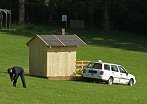


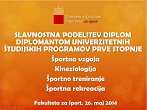





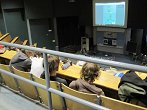





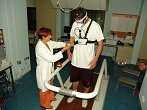
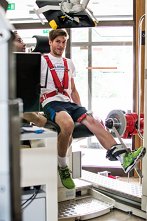
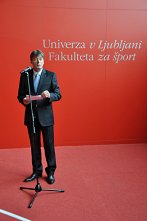



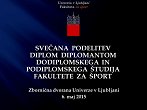





.png)